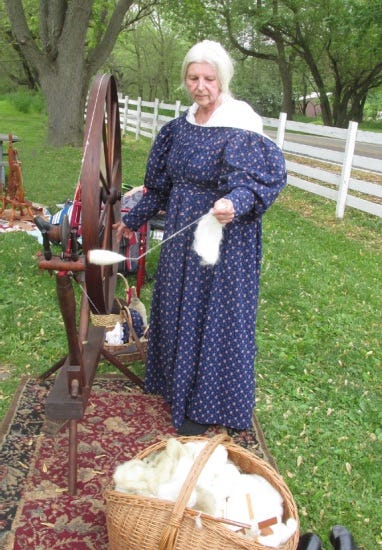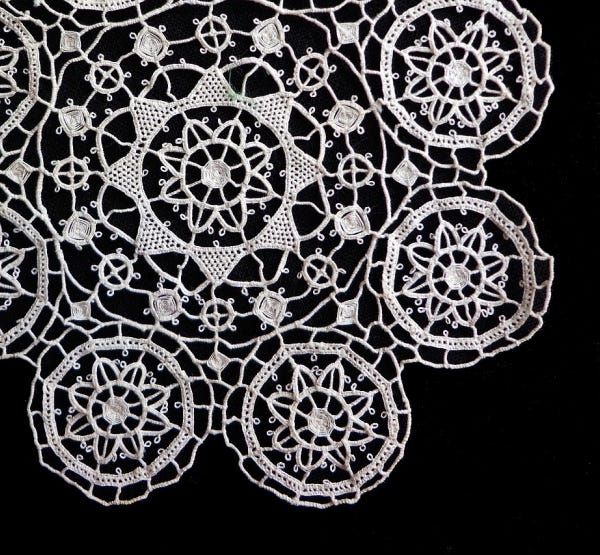If you have an interest in old lace, There are other illustrated articles on Leaves🌿. Click HERE
A neighbor asked me if I would be willing to sell some antique needle lace for her on eBay. I knew as much about antique lace as I did about the suspension system on a ‘65 Mustang, which is to say, absolutely nothing. So naturally I said, “Of course! Bring them on over.” I photographed her laces and wrote out what I thought were sound, albeit generic, descriptions of them. For the sake of honesty, I admitted in the text that I was not exactly an expert in the field, an understatement if there ever was one. Then I thoughtfully considered, “Let’s see.... how much would I , myself, pay for these little bits and bobs? And priced them accordingly.
Not more than three hours after listing, I received an eBay message from a stranger. She gently advised me that the laces I had for auction were far more valuable than the prices at which I was offering them. She told me exactly what kind of lace each one was and the value I should use to start each auction. In my total ignorance, I had offered the five pieces for a combined sum of $70. Acting on this woman’s advice, I revised the listings and I sold them all for a very happy neighbor for $1,400. Thus began my journey into the mystery world of antique lace — I was an old dog and I was learning new tricks at the hand of a master.
Over the next seventeen years, my mentor, Kate Henry, taught me so much — or rather, she bravely tried to. I learned to identify the smallest of Belgian bobbin lace appliqués and the largest of Italian needle lace altar cloths. She explained to me, in brain-boggling detail, the characteristics of Slovene Idrija lace, Maltese silk lace, British Honiton and the Bedfordshires, and so many more. Still, after all these years, I feel I know less than one tenth of one percent of what could be known, and I continue to call on her all too often to help me put a name on some new discovery. Ultimately, she and I turned out to be the perfect duo: my enthusiasm is high, my retention is remarkably short. Her patience, apparently, is infinite.
Kate is a Renaissance woman – she has profound knowledge and capabilities in many different areas. She is a well-known maker of intricate bobbin laces, she advises museums about their lace acquisitions, and offers lectures and workshops at lacemakers’ conventions. Her patchwork quilts are lovingly constructed from recycled scrap. She spins her own yarn from sheep wool and, yes, even from dog hair. She dyes her yarns with natural colorants, and weaves them on a loom. She creates historically accurate ribbon braid for military costumes, as well as yards and yards of wide woven wool plaid fabric. She is commissioned to make intricate bobbin lace on consignment to exact specifications. Kate is a genius, and yet, you would never meet a kinder, more down-to-earth woman. I feel honored to have been taken on as a protégé all these years. How could I have been so fortunate!
Lace is a vast world of artistry and skill. There are hundreds of types of laces. It is made in nearly every country of the world, and there are women all over the planet today who are trying to keep this traditional needle and bobbin art alive. Lacemaking schools and guilds have been established, online educational websites and tutorials have become available, Youtube instructional videos are numerous, not to mention the many books that have been published on the subject.
I have now bought and sold close to a thousand pieces of antique lace, getting them into the hands of those who will cherish and preserve them. Because I didn’t want my photos — and my growing proficiency, to go to waste, I began a lace identification website for beginners, called Rook and Raven. My teacher, who is now retired, has been so very helpful to me, I want to “pay it forward” to others who have a nascent interest in antique lace – both as an art form to collect or as a handcraft.
For the bewildered beginning lace collector, over 600 close-up photos of fine old laces have been categorized and labeled. Visitors are encouraged to browse the galleries, enlarge the photos, and get acquainted with the look of various types of antique needlework.
Rook and Raven has now had nearly 154,000 visitors who seek advice and information about lace. I find the number encouraging. Even though I consider myself still at a basic level, in my own small way I can be an active part in keeping this grand art alive. Below are a few examples of different laces as shown on my lace website.
My reference website, Rook and Raven - Identifying Antique Lace, can help you identify and learn about antique lace. rookandraven.weebly.com
My little store on ebay, The Rook and The Raven, offers modest laces and linens https://www.ebay.com/str/therookandtheraven

















Wow Sharron, I guess I never gave lace much thought. My mother had various pieces on table tops etc. which I assume have been lost to time. The work is so intricate and detailed. I's good that people like you and Kate are keeping the appreciation for such fine crafting alive.
Fascinating! I never gave lace much thought except for how long it would appear to take to complete a piece. Definitely works of art.